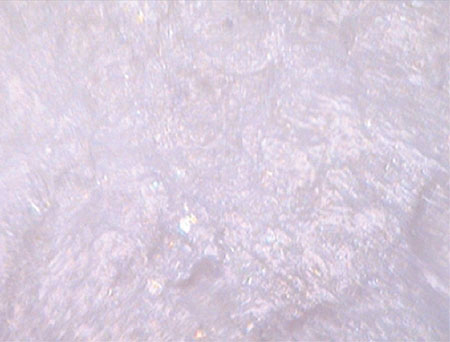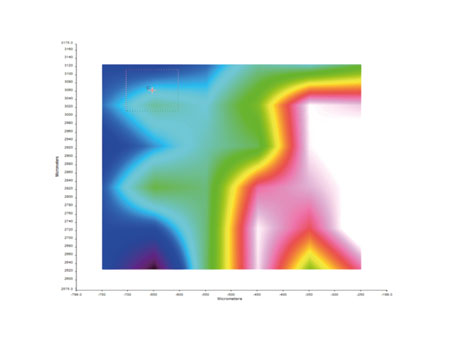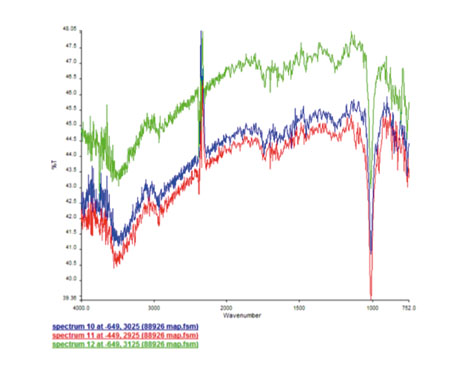Chemical analysts have long sought a direct and non-destructive method for identifying chemicals or materials within different formulation environments. Classic methodologies, such as high pressure liquid chromatography or gas chromatography, coupled with mass spectroscopy, scanning electron microscopy and nuclear magnetic resonance, require expensive equipment and incur high maintenance costs. Often they require sample preparation, resulting in long and expensive analytical processes. In addition, such equipment is not mobile enough to enable it to be brought to the point of interest.
The recent advances in FTIR and NIR technologies allow a simple sample analysis without extensive sample preparation. Complex mixtures within formations can be deduced by using reference sample subtraction followed by further comparison with known references.
The pharmaceutical and chemical industries share similar operational, product quality and regulatory requirements to produce safe products with controlled operations.
Quality issues can arise when raw materials are exposed to particular situations that may result in contamination from equipment, shipping materials, human source, or due to temperature, oxidation or moisture effects. Poor manufacturing, handling or packaging control can also introduce potential contaminants that may cause product quality failure.
To ensure product quality and safety, regulatory agencies such as the US Food and Drug Administration (FDA) recommend good quality control of raw materials and processes used in pharmaceutical and chemical manufacturing. Lot to lot variation of the raw materials needs to be understood and controlled to validate manufacturing processes. FTIR and NIR can be useful non-destructive techniques used to identify the consistency of the incoming raw material compared with the acceptable reference material. Prevention of product failure at this stage of the manufacturing process is less costly than rejection of the finished product.
The pharmaceutical industry is gaining interest in the use of FTIR and NIR as non-destructive methods for quantitative analysis of a mixture, reverse engineering and chemical imaging. Many pharmaceutical coating products typically contain biopolymers, filler, inorganic pigments, lubricant, active pharmaceutical ingredients and other excipients. These ingredients can consist of solid or viscous liquids, organic or inorganic components, polymeric or small molecules. Controlled pharmaceutical manufacturing processes can be improved using quantitative process outputs. The output quality relies on the quality of the process inputs and accuracy of the data.
Input controls have been accepted as process control because until now there has been no better way to quantify material mixtures of complex composition. With the advent of new FTIR and NIR technologies, advances in complex mixture analysis have been made.
| Potential applications of FTIR and NIR technologies |
| Material identification (Quality Control) |
| – Raw materials |
| – Products |
| – Contaminants |
| Material degradation |
| – Gas |
| – Emulsion |
| Environmental |
| – Air quality |
| – Water quality |
| Materials chemical compatibility |
| – Polymeric materials in contact with organic materials |
| Non-destructive method for quantitative analysis of a mixture |
| Reverse engineering (de-formulation) |
| Chemical imaging |
For example, a film coating mixture for tablets consisting of three excipients, a film former (organic), opacifier (inorganic) and a liquid plasticiser (organic), were successfully validated and quantitatively analysed using NIR. The individual components were scanned by NIR and a model was built using Principle Component Analysis (PCA). Five different formulas were created by varying the key ingredients using Design of Experiments Mixture Design as illustrated in Table 1. These five formulas were tested for their NIR detection reproducibility and linearity. Note that all components had repeated high and low levels and one centre point.
| Table 1: Design of Experiments for method calibration and validation | ||
| Film Former (%) | Colorant (%) | Liquid plasticiser (%) |
| 40.0 | 55.0 | 5.0 |
| 40.0 | 50.0 | 10.0 |
| 60.0 | 30.0 | 10.0 |
| 60.0 | 35.0 | 5.0 |
| 50.0 | 42.5 | 7.5 |
Each NIR vendor has software for the multivariate analysis required to identify the PCA, making the analysis simple. The PCA was obtained from absorbance, first or second derivative of the spectra. The calibration curve was then developed using multiple component regression, principle component regression and/or partial least square regression. The best regression model was then selected. Once the reproducibility and linearity within the design space are established, the residual values obtained from the difference between the predicted values and the real values demonstrate the method of validation within the design space (Figure 1). An unknown formula can be made and used to confirm the method’s validity.
Once the library of raw materials is available, it is easy to identify composition mixtures by grouping. Additional material on the composition is also available from the product label. NIR can easily quantify the individual components as a reverse engineering technique.
Further advances have been made in the use of FTIR for protein primary and secondary structure characterisation based on the amide linkage of the peptides. Protein activity is extremely sensitive to environmental conditions such as pH, ionic strength and temperature and any resulting folding and re-folding of the protein can affect the biological activity. Using FTIR to determine the protein stability in its natural environment is both simple and economical.
The use of FTIR/NIR/Raman IR coupled with optical fibres is also gaining acceptance due to instrument and testing mobility. The instruments can be brought to any location to enable environmental sampling, process control or raw materials testing.
FTIR-microscopy is an economical technique in which the image of a material surface can be used for identification of its components. FTIR-microscopy can be used to obtain the chemical identity of material within a 1000 x 1000 µm area on the surface of a solid sample. The scanned spectrum can be compared with a spectral library to identify a single component material or components of a simple mixture.
A larger surface area can be scanned by the FTIR-microscopy to create a chemical image based on reconstruction of chemical component spectra using the PCA. This chemical imaging technique can differentiate between the various chemical components and determine the distribution of a particular material over a surface. This technique can be applied to solid dose pharmaceuticals to determine the uniformity of the active pharmaceutical ingredient or functional excipient throughout the tablet. The information based on chemical distribution data can be used to assess the critical quality attributes leading to better process control.

Figure 2: Spectrablend II coated tablet under magnification
For example, white film-coated tablets may look uniform, but under magnification, further structural details are revealed (Figure 2). With FTIR mapping, the chemical distribution of the individual materials can be identified showing the uniformity or non-uniformity across the tablet. The colour contour map shown in Figures 3 and 4 illustrates the different chemical composition at different regions on the surface. It is particularly useful for identifying contaminant materials on the surface.

Figure 3: Chemical Image over 600 x 600µm. The different colours represent the different IR spectra obtained (see Figure 4), reflecting different materials

Figure 4: Chart showing the spectra of different materials
In summary, infrared spectroscopy is a convenient technique for obtaining information about materials used in complex mixtures and in finished goods. This information is invaluable as it provides non-destructive sample identification for industrial applications such as quality and process control. The addition of small window FTIR microscopy offers a powerful tool for chemical imaging to verify product quality, resolve material contamination issues and for process control troubleshooting.




